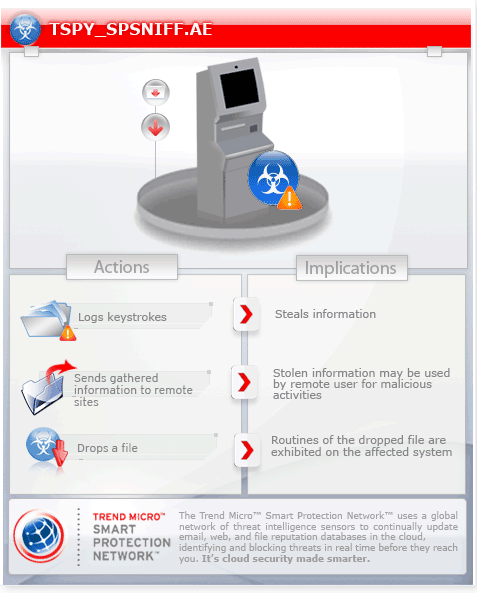TSPY_SPSNIFF.AE
Trojan:Win32/Dynamer!dtc (Microsoft); Trojan-Spy.Win32.SPSniffer.c (Kaspersky)
Windows 2000, Windows XP, Windows Server 2003


Threat Type: Spyware
Destructiveness: No
Encrypted: No
In the wild: Yes
OVERVIEW
This malware is designed specifically to steal sensitive information such as Personal Identification Numbers (PINs) from devices with PIN pads, such as ATMs.
To get a one-glance comprehensive view of the behavior of this Spyware, refer to the Threat Diagram shown below.

This spyware arrives on a system as a file dropped by other malware or as a file downloaded unknowingly by users when visiting malicious sites.
It logs a user's keystrokes to steal information.
TECHNICAL DETAILS
Arrival Details
This spyware arrives on a system as a file dropped by other malware or as a file downloaded unknowingly by users when visiting malicious sites.
Dropping Routine
This spyware drops the following file(s), which it uses for its keylogging routine:
- systen.dll
Information Theft
This spyware logs a user's keystrokes to steal information.
Stolen Information
This spyware sends the data it gathers to the following email addresses via SMTP:
- {BLOCKED}shydra@gmail.com
- {BLOCKED}dosteste@yahoo.com.br
NOTES:
It requires the following .DLL files in order to run properly:
- spsax.dll
- spsniffer.dll
The said DLL files are bundled with Serial Port Sniffer ActiveX Control and Serial Port Monitor Activex from Eltima Software.
It also saves system information such as host name and user name in the file systen.dll.
It uses the following SMTP servers to send its stolen information:
- {BLOCKED}il.cg.shawcable.net
- {BLOCIED}ail.yahoo.com
SOLUTION
Step 1
For Windows XP and Windows Server 2003 users, before doing any scans, please make sure you disable System Restore to allow full scanning of your computer.
Step 2
Identify and terminate files detected as TSPY_SPSNIFF.AE
- If the detected file is displayed in either Windows Task Manager or Process Explorer but you cannot delete it, restart your computer in safe mode. To do this, refer to this link for the complete steps.
- If the detected file is not displayed in either Windows Task Manager or Process Explorer, continue doing the next steps.
Step 3
Search and delete this file
- systen.dll
Step 4
Scan your computer with your Trend Micro product to delete files detected as TSPY_SPSNIFF.AE. If the detected files have already been cleaned, deleted, or quarantined by your Trend Micro product, no further step is required. You may opt to simply delete the quarantined files. Please check this Knowledge Base page for more information.
Did this description help? Tell us how we did.


